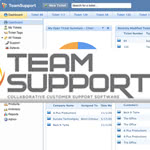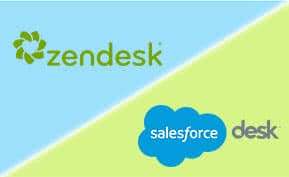Customer Service
Let's Talk TeamSupport: Behind the Software with CEO Robert Johnson

Now more than ever a company’s customer support services can make or break its public reputation. Customer support start-up TeamSupport devised a progressive software platform to help companies (and consumers) avoid the inevitable conversation loop that comes from speaking with an unqualified individual. We talked with CEO Robert Johnson about the foundation of their unique customer service solution, and how their SaaS delivery method helped the company successfully navigate the recession.
How did Muroc Systems and TeamSupport come about? What gap in the customer service market did you see that you were trying to solve?
WEBSITE: www.teamsupport.com
LAUNCHED: 2008
LOCATION: Dallas, TX
CUSTOMERS: Axceler, Talon Data Systems, Wren Solutions, Global Systems Integration
Like all good entrepreneurs, we’re always looking for problems to solve, and in this case the problem really stemmed from our personal experiences. Myself and most of my team were part of a TV automation company that I ran from 1997 to 2006. We controlled the playback of commercials and programs at TV stations around the world and, as I joke fairly often, I can almost guarantee you saw our work and hopefully never noticed it.
One of the things we found while running that company was that customer support was absolutely critical to the growth of our company. In that time-frame we were in a very tight vertical market and, even though the technology didn’t exist as we know it today in the social networking space, the idea of people talking about the product to their peers certainly did. So your reputation really meant everything in that particular space.
We’d looked long and hard at the customer service market and really didn’t find anything that was suitable for a B2B technology company such as ourselves, so we developed some internal software to manage that support process for us.
Now fast forward several years, where I was looking to start another company and again, trying to solve a problem that we already knew and a space that we understood very well. That’s really why we founded TeamSupport. I hired a number of guys from my old company, who came from a similar background. We all saw the problem very similarly and we created Team Support based on that experience and knowledge.
You founded the company during the beginning of the recession — what challenges did you face as a start-up during a severe economic downturn?
Of course, looking back, I’m not sure that I would have picked that time as ideal to start a company, but it actually turned out to be a great time for us to do it.
I had been in the oil and gas business as well, so the theory was to fund the growth of my new technology start-up using some of the proceeds from my oil and gas company. And that worked great for a while. But one of the things that really affected us was the price of oil went from $137 a barrel to about $30 and change — so we dried up that cash flow very, very quickly.
Starting a new software company certainly was challenging from a sales perspective, because companies really weren’t looking to spend on new technology at the time. On the flip side, because we’re a SaaS solution and no capital was required, we did see a number of companies purchase our product who would not have done so if we were a traditional enterprise software provider.
SaaS has been a great business model for both our customers and for us as well, and certainly in a time when a lot of companies were tightening their belts and looking very seriously at capital expenditures. They were more open to using OPEX, to basically use the software on a month-to-month basis. OPEX was still a somewhat new concept, but I do think that actually helped accelerate our growth because we were not requiring CAPEX.
But certainly starting a company in a recession has some benefits as well. One of the nice things was that everything — from employees’ salaries to office space to technology — was on fire-sale from about 2008 through 2010, and even later in some cases. So it actually ends up being a very good time in many ways to start a company, just because your start-up costs end up being a lot cheaper.
What makes TeamSupport stand out from other customer service applications?
The classic customer support model has been that one customer talks to one agent, and we just felt that model was broken. We’ve evolved that model to have teams working on customers, and we built TeamSupport from a collaboration standpoint. We wanted to let everybody work together and to really be able to share knowledge and collaborate — that results in customer problems getting resolved faster and it results in happier customers.
We’ve got a number of great collaboration features in TeamSupport that allow everybody to work together. The one I like the most in the product is something called the Water Cooler, which is thought of as a social network built into your support desk. Imagine a Google Plus or a Facebook directly in your help-desk application to allow you to reach out to other colleagues. You can use it to ask questions and find the expert on a particular issue to make sure customers’ problems get solved very quickly and by the right people.
How have you worked to keep TeamSupport a relevant and noteworthy product?
I think one of the areas that we are really different and strive to be different in is that we focus on a slightly different market niche. We focus primarily on B2B technology companies — and that’s the background we came from and what we really know. We certainly have a lot of B2C customers, but the software is written primarily for a software or technology company that sells to other businesses.
We also focus heavily on collaboration — that’s a key part of our offering. We really believe that customer support is not just something that needs to be buried in the customer support department in the call center. Addressing your customers’ needs and making sure they are very happy with their product is something that really should start with the CEO on down and be part of the entire company. I‘m a strong believer in having the entire company involved in that process, and also being able to work together very closely with everybody.
As far as maintaining a relevancy in the marketplace, that’s not a SaaS issue at all, but a software issue. No matter what industry you’re in and what software you’re producing, you have to continue to innovate. You have to continue to listen very closely to your customers, and you have to make sure that your software is providing an excellent solution for your customer base.
How would you describe your ideal customer?
Our ideal company customer is really a B2B technology and software company and that again comes primarily from our background. We understand that market very, very well. We lived that market for a number of years, and the problems that we talked to our customers about then are surprisingly common across our entire customer base.
That’s really the market segment we want to address, and we’ve made the TeamSupport tools specifically for that particular market segment. That being said, we do have customers all over the map — in a broad sense, really any company that has a customer can benefit from a tool like TeamSupport.
Has your target user changed from your initial vision or starting point?
When we first started the company, we really saw TeamSupport as a kind of three-pronged approach. We saw it certainly as a customer support piece. We also saw it though as a bug-tracking system and a feature-tracking system. So really we were targeting software companies and saying, ‘Hey, put your developers on this, put your product management people on this, and put your customer support people on this.’ You would have all of your direct customer-facing group that deals with the product and deals with customers working on one platform.
And we still love that idea and we’ve had a lot of companies that use us that way. Unfortunately, what we found from a sales perspective is that we would end up having to sell to 2, if not 3 or more, different departments in a company. That became a very big sales challenge, and all it took was one division of the company to say we don’t like it for the entire sales pitch to go down the tubes.
It took us a little bit of time to realize that we had bitten off a little more than we could chew from a sales perspective. So we looked at our model and asked what is the best problem we are solving, and where’s the biggest pain point? Across the board the answer was customer support, and that’s really where we found our entrance into a company almost always was. So we adopted the marketing message to say, ‘Hey, we are the best support product out there,’ and we found the pain point was much easier to address directly in the support market.
Have you experienced any unusual challenges while building and maintaining a SaaS customer service solution with unique collaborative capabilities?
I’m not sure any problems we had were particularly unique to us. There are certainly a lot of issues unique to the SaaS platform versus an installed platform. There are a lot of benefits to the SaaS world, but there are also a number of detriments. For example if we roll a version of software out it goes to everybody, and if we have not done as good of a job in our Q&A process as we should have then everybody has a bug, not just 1 or 2 select customers. The benefit of course is we have everybody running on the same version of software. We don’t have 20 different versions of software running out there.
We do have issues, again, just like every other sales company, in dealing with browser compatibility. That’s something that I really didn’t understand the full scope of when we started this company, that browsers are not all created equally. Whether it’s Chrome or IE or Firefox or Safari, they each have their own little differences and we have to work to ensure that our software works equally among all.
One of the great things though is that we eat our own dog food, so to speak. We actually use TeamSupport to support our own customer base. As a customer of our own product, that allows us to understand the tool much better. We can use ourselves as guinea pigs in many cases to test new features before we try to roll them out to a larger customer base. But the fact that we actually use our own product every day and it’s a mission-critical piece of our internal operations is a pretty neat thing we’re able to do.
Are there any new features or functionality that users should be on the lookout for, either from your company or more generally in the industry?
Certainly collaboration — that’s one of the key terms out there that we hear over and over again in a number of different areas. It’s been interesting to watch the consumer-type apps, like Facebook, Google Plus, Pinterest, starting to move into the enterprise. We’ve done a lot of that with Water Cooler. The idea of friends collaborating and being able to share information with each other certainly has a great deal of benefit in the enterprise.
I do think from a very broad perspective on enterprise software that SaaS is the new norm. I don’t think many people would argue that anymore. Going back to the early days, we would have customers say they can’t do hosted software — but that really has gone away. It’s very, very rare for us anymore to have somebody say, ‘We can’t do a web-based app, we have to install a version of this software.’
One more thought popped in my head is that very broadly in the customer support space, we’ve been seeing a trend where companies are starting to understand that customer support is critical to their success. It was not many years ago that the support department was really considered an afterthought, a division of the company that sucked resources and had no benefit, but was something companies had to do.
We’ve seen a seminal shift over the last 4 or 5 years where CEOs are really understanding that support is a key piece of how they do business, and that it can be a major differentiator for them. I think that’s a very positive change for consumers as well. That need is certainly something that our tool helps with, and we expect to help push that concept and ride that wave for the next several years.
Want to learn more about TeamSupport and other customer service platforms? Check out our side-by-side comparison of leading solutions in the Top 10 Customer Support Software report. You can also browse exclusive Business-Software.com resources on customer support solutions by visiting the customer service research center.





